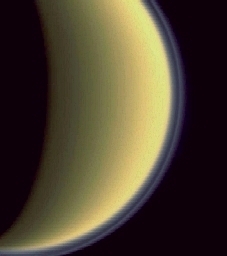
 Life Precursors in Haze Layers?. Cassini-Huygens is a NASA/ESA/Italian Space Agency mission to Saturn. Like Galileo had been the first mission ever orbiting a gas giant, Cassini-Huygens will work in orbit around Saturn for a thoroughful study of the ringed planet's system. Titan is one target of the mission, and a dedicated study for the piggyback Huygens probe which will parachute in the moon's atmosphere in search of life primordial building blocks. Seen here, as the mission was flying by the moon after the Saturn orbit insertion maneuver, is the atmosphere of Titan. Two distinctive haze layers are seen, the outer one being detached. Such layers are the result of the action of Sun ultraviolet radiation in the high atmosphere, at altitudes above 250 mi (400 km). Nitrogen and methane molecules are broken down and transformed into complex organic molecules. It is such molecules combining in small particles which are forming the haze layers. Such a process might have been a way how life appeared at Earth. Mars, Titan, and some of Jupiter icy moons are places of interest for life search in the solar system. The outer layer is hanging at a little more than a hundred miles (a few hundred kilometers) above the surface and is 75 mi (120 km) thick. picture courtesy NASA/JPL/Space Science Institute
Life Precursors in Haze Layers?. Cassini-Huygens is a NASA/ESA/Italian Space Agency mission to Saturn. Like Galileo had been the first mission ever orbiting a gas giant, Cassini-Huygens will work in orbit around Saturn for a thoroughful study of the ringed planet's system. Titan is one target of the mission, and a dedicated study for the piggyback Huygens probe which will parachute in the moon's atmosphere in search of life primordial building blocks. Seen here, as the mission was flying by the moon after the Saturn orbit insertion maneuver, is the atmosphere of Titan. Two distinctive haze layers are seen, the outer one being detached. Such layers are the result of the action of Sun ultraviolet radiation in the high atmosphere, at altitudes above 250 mi (400 km). Nitrogen and methane molecules are broken down and transformed into complex organic molecules. It is such molecules combining in small particles which are forming the haze layers. Such a process might have been a way how life appeared at Earth. Mars, Titan, and some of Jupiter icy moons are places of interest for life search in the solar system. The outer layer is hanging at a little more than a hundred miles (a few hundred kilometers) above the surface and is 75 mi (120 km) thick. picture courtesy NASA/JPL/Space Science Institute
Website Manager: G. Guichard, site 'Amateur Astronomy,' http://stars5.6te.net. Page Editor: G. Guichard. last edited: 12/28/2010. contact us at ggwebsites@outlook.com

